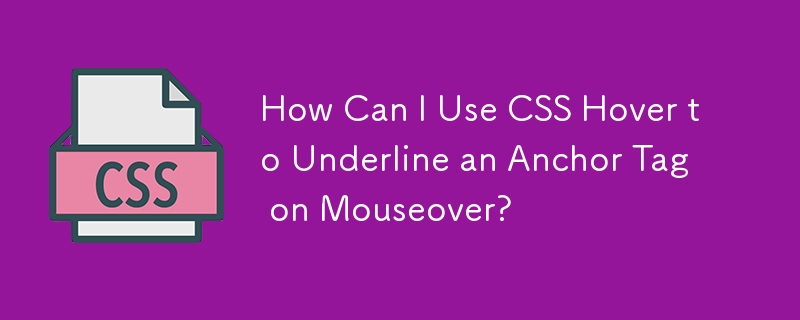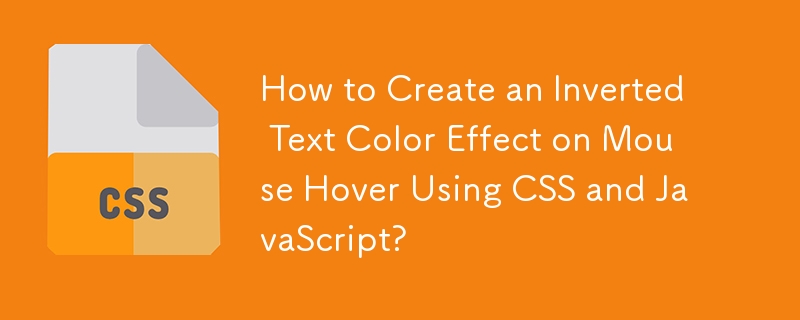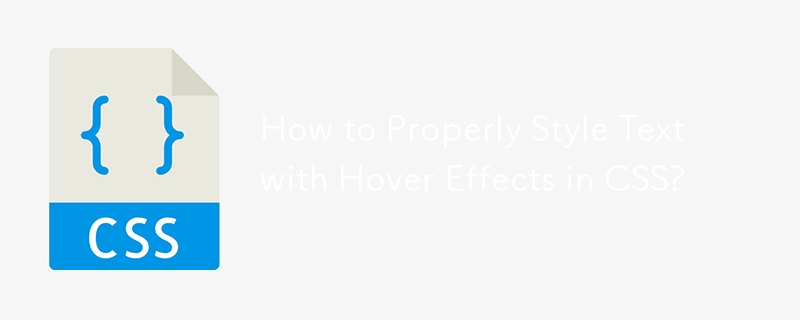Found a total of 10000 related content

What is the difference between and HTML tags?
Article Introduction:and is used for pure style bold and italics, without semantics; and is used to emphasize content. 1. Make the text bold and italicize the text, both of which only affect the appearance. 2. It indicates important content, usually displayed in bold; it indicates emphasis, usually displayed in italics. 3. If the style effect is required and there is no emphasis on intention, use or; if the importance or tone changes are needed, use or.
2025-06-29
comment 0
686
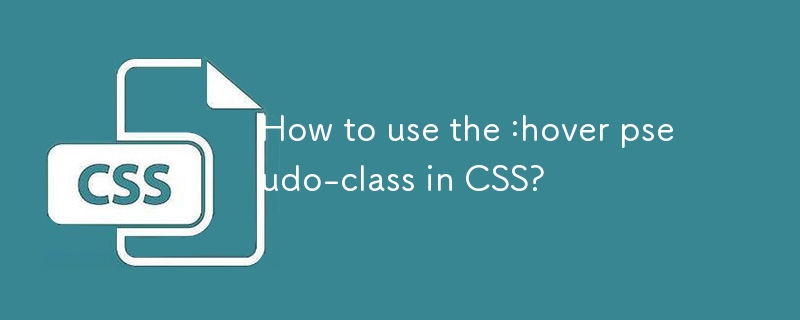
How to use the :hover pseudo-class in CSS?
Article Introduction:The :hover pseudo-class is used to realize style changes when mouse hovering. It is suitable for various elements such as buttons, menus, pictures, etc. The basic writing method is to add :hover after selectors, such as button:hover{background color change}. Common uses include button interaction, drop-down menus, picture enlargement, prompt display, etc. When using it, you need to note that the mobile hover may only trigger when clicked. The structure nesting may cause style failure. The z-index level, style coverage and debug with developer tools. At the same time, pay attention to compatibility and performance to avoid excessive animations affecting the experience.
2025-07-17
comment 0
287

How to create 3D three-dimensional text effects on PS?
Article Introduction:There are three main ways to create 3D three-dimensional text effects in Photoshop: 1) Use 3D tools, 2) Layer styles, and 3) Manual drawing. First, when using the 3D tool, create a new document and enter text, select the text layer and select "New 3D Highlight Effect from Selection", and then adjust the rotation, zoom, and position. Secondly, adjust the Depth, Size, and Softening parameters through the Bevel and Emboss options in the layer style to simulate the 3D effect. Finally, manual drawing methods require more skill and time, but with complete control over the effects.
2025-05-15
comment 0
703
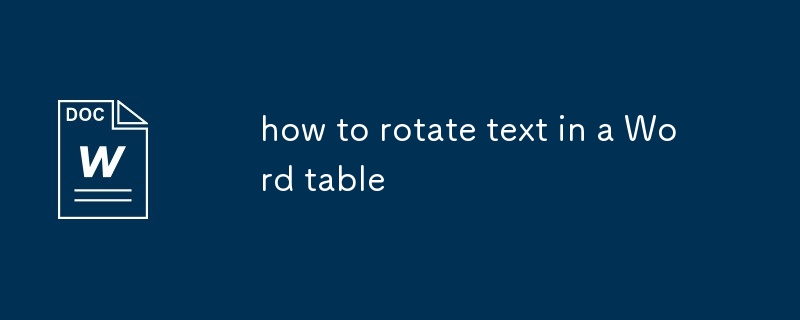
how to rotate text in a Word table
Article Introduction:To rotate the text in a Word table, the easiest way is to select the cell and click the "Text Direction" button under the "Layout" tab and select the preset style; if you need to adjust in batches, you can set the text direction in the cell alignment by right-clicking "Table Properties"; if you need to manually control the direction of each character, you can set the text direction to "From Top to bottom", press Shift Enter to wrap the line when entering text, and adjust the font size and cell width to achieve neat effect.
2025-07-16
comment 0
310
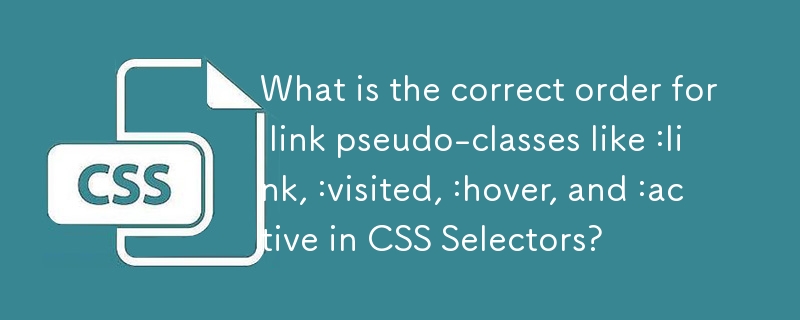
What is the correct order for link pseudo-classes like :link, :visited, :hover, and :active in CSS Selectors?
Article Introduction:In CSS, the order of pseudo-class selectors: link, visited, :hover and :active is very important. They must be written in the order of LVHA (Link→Visited→Hover→Active), because if the styles are of the same priority, the subsequent rules will override the previous one; 1.:link sets the unvisible link style; 2.:visited sets the accessed link style, but is subject to browser privacy restrictions; 3.:hover sets the mouse hover effect, and the mobile terminal may need additional processing; 4.:active sets the style when clicking to provide instant feedback; this order ensures that all statuses can be displayed correctly to avoid browser inconsistencies.
2025-06-28
comment 0
977

Bootstrap Navbar: How to change style
Article Introduction:You can customize the style of BootstrapNavbar through the following steps: 1. Use CSS to modify the background color, text color, fill and hover effect; 2. Add logo and use Bootstrap's grid system to change the layout. When customizing, you need to be responsive, avoid overcomplexity, and consider performance impacts to ensure a balance between user experience and website performance.
2025-06-26
comment 0
219
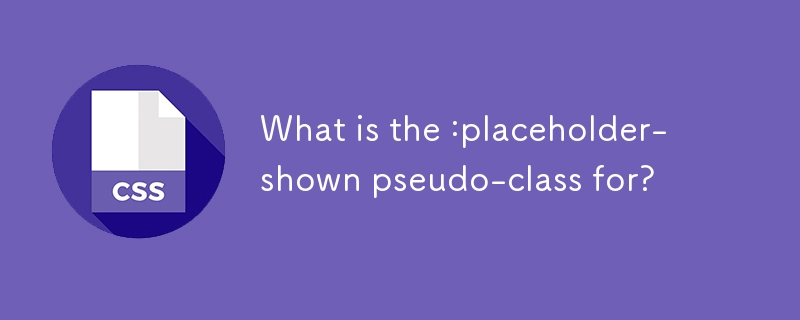
What is the :placeholder-shown pseudo-class for?
Article Introduction:The :placeholder-shown pseudo-class is used to style the input box when the placeholder text is visible, and it takes effect when the user does not enter content. 1. It is suitable for form scenes that require visual feedback, such as distinguishing empty fields from filled fields; 2. It can be used to adjust borders, background colors or control other elements to display and hide; 3. It acts on elements with placeholder attributes; 4. Common uses include highlighting required items, changing border colors or adding transition animations; 5. Pay attention to its incompatibility and its differences from ::placeholder, which is used to directly style the placeholder text.
2025-07-11
comment 0
904

How to handle mouse events on a canvas?
Article Introduction:To handle mouse events on canvas, you need to manually monitor and judge the trigger area in combination with coordinates. 1. When obtaining the mouse position, you need to convert clientX and clientY to the internal coordinates of canvas. The formula is x=e.clientX-rect.left, y=e.clientY-rect.top; 2. If there is a zoom or transform style, the coordinates need to be adjusted accordingly; 3. To determine whether to click on the graphic, you need to record the graphics information in advance and detect whether the coordinates fall in the corresponding area when clicking; 4. To achieve the hover effect, you can listen to mousemove and clear and repaint canvas or use double buffering technology; 5. Note that the mobile terminal needs to use touch events to replace hove
2025-06-26
comment 0
643
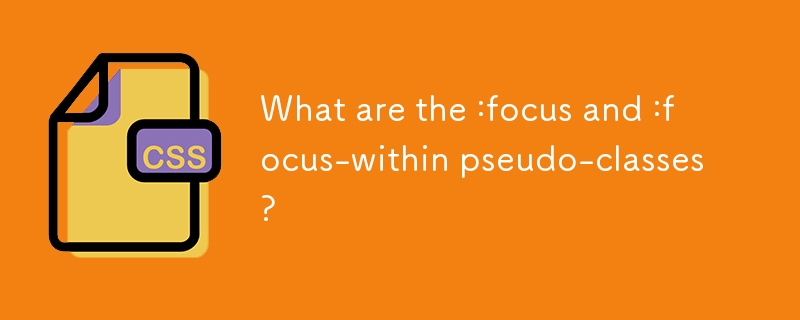
What are the :focus and :focus-within pseudo-classes?
Article Introduction::focus is used to directly focus the element itself, and :focus-within is used to affect the parent container when the child element gets focus. 1.: focus only takes effect on the current element and is often used for input box highlighting; 2.: focus-within is applied to containers containing interactive elements, and when their child elements are focused, triggering style changes, such as the overall highlighting of form groups or search box; 3. When using it, you should ensure accessibility, retain clear focus indicators, and combine them with keyboard navigation tests. Together, the two improve the usability and user experience of the interface.
2025-06-27
comment 0
352

What is the difference between and elements?
Article Introduction:The core difference between the and is the display behavior: it is a block-level element, which occupies a single line and supports the width; it is an in-line element, which only occupies the required width of the content and does not wrap the line. When used, it is suitable for layout structures or grouped chunk-level content, such as containers, blocks, or scenes where a new line is required; it is suitable for style control of small-scale content in paragraphs, such as highlighted text or local style adjustments, without affecting text flow. The two respond differently to CSS attributes by default: width, height and margins can be set directly, and the display attribute needs to be modified to inline-block or block to take effect. When choosing, it should be determined based on the layout requirements and semantic structure, and style or script operations should be performed in conjunction with the class name or ID.
2025-06-20
comment 0
817

How to Create a CSS3 Blurred Text Link Effect
Article Introduction:Detailed explanation of the effects of fuzzy text in CSS3 and FAQs
Key Points
CSS3 can create blur text effects with transparent text colors and text shadows, but not all browsers support the text-shadow property. In this case, you can use Modernizr or write custom text shadow detection code as a workaround.
A pleasant effect can be achieved for the navigation menu by smoothly blurring the links in and out while hovering or focusing. This involves defining a "blur" class that can be applied to any link and then using a CSS style that can be applied in all browsers.
When creating blurred text effects, be sure to pay attention to accessibility and visibility issues. In addition, the third text shadow can be adjusted by adjusting
2025-03-04
comment 0
460

how to use format painter in Word
Article Introduction:The use of format brushes includes: clicking once can apply the format once, and double-clicking can be used continuously; being able to copy fonts and paragraph formats such as line spacing, indentation, etc.; it can be used to copy formats across documents. When the operation is done, first select the set text, click "Format Brush", and then brush the target content. After double-clicking, you can brush multiple places continuously. Press the Esc key to exit after completion. Format Brush can not only copy the character format, but also copy the paragraph format; when using cross-document, you need to pay attention to style differences and check the effect.
2025-07-12
comment 0
629

how to compare two Word documents for differences
Article Introduction:To compare the differences between two Word documents, use Word's built-in "Compare" feature or online tools. First, use the "Compare Document" function in the "Review" tab of Word to select the original and revised documents to generate comparison results, which can clearly display changes such as text addition and deletion, format adjustment, and support item-by-item acceptance or rejection of changes; secondly, if the full version of Word is not installed, you can upload files to automatically compare files with online tools such as Diffchecker, WordHacker, DocxCompare, etc., but you need to pay attention to the risk of sensitive information leakage; finally, when checking format differences, you can view paragraph settings and font parameters through the "Style Checker" and selected content to ensure the unified layout to improve the professionalism of the document.
2025-07-06
comment 0
562

What is the role of initialization parameters (pfile vs. spfile) in Oracle database startup?
Article Introduction:Oracle database starts with initialization parameters to define instance behavior, which are stored in PFILE (text file) or SPFILE (binary file). 1.PFILE is a text file that can be edited manually, while SPFILE is managed by Oracle and supports dynamic modification. 2. SPFILE supports persistence and session-level changes. After PFILE is modified, it needs to be restarted to take effect. 3. When Oracle starts, please be given priority to looking for SPFILE. If not, use PFILE. 4. You can convert file types to each other through the CREATESPFILE/PFILE command. 5. Use SHOWPARAMETERspfile; you can view the file type currently used. Select the correct file type
2025-06-08
comment 0
859

The greatest Google Docs shortcut you’re probably not using
Article Introduction:When co-editing Google Docs documents, switching between editing mode and suggestion mode is crucial. However, the traditional method—mouse click—is inefficient. This article introduces shortcut keys to help you quickly switch modes.
The editing mode directly modifies the document, and there is no trace of modification of the final version, but the version history can be checked.
The recommended mode will mark all modifications: deleted text will be marked with deletion lines, and newly added text will be marked with underlines. Different users have different colors for modification, which is convenient for distinguishing. Each modification will also be accompanied by a sidebar note, explaining in detail the differences before and after modification.
It is recommended that the mode is suitable for larger modifications, while the edit mode is more suitable for minor changes, such as correcting typos or punctuation marks.
Shortcut key switching mode:
Switch from edit mode to suggested mode:
W
2025-02-26
comment 0
323
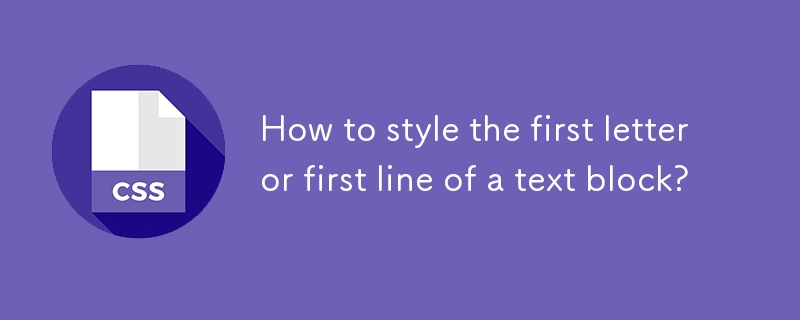
How to style the first letter or first line of a text block?
Article Introduction:In web design, using CSS pseudo-elements can achieve the style beautification of the first letter or first line of the text block. 1. Use ::first-letter to add styles to the first letter of the paragraph, such as getting bigger, discolored, floating, etc., which are often used for the "capsular letter sinking" effect; 2. Use ::first-line to set indentation, color, background and other styles for the first line of the paragraph; 3. When applying, it is necessary to note that both are only suitable for block-level elements, and reasonably set attributes such as margin and float to avoid typography confusion; 4. In actual development, it is often used for content display scenarios such as article text, blog summary, etc., and combined with font services and responsive design can improve visual hierarchy and readability.
2025-06-30
comment 0
321

Adopting CSS Logical Properties for Internationalization and Flexibility
Article Introduction:CSS logic attributes are a style tool that automatically adjusts layout according to the direction of content writing. They are different from traditional physical direction properties such as margin-left, but use logical directions, such as margin-inline-start, which can automatically adapt to left and right margins according to language direction. Common logical properties include inline (in-row direction) and block (block level direction), such as padding-inline-start and margin-block-end. Its advantage is that when dynamic text direction changes in international projects, it reduces redundant styles and improves component reusability. When applying, you need to pay attention to browser compatibility, debugging intuition and naming habits. In actual cases, the button can be set to a
2025-07-12
comment 0
441
